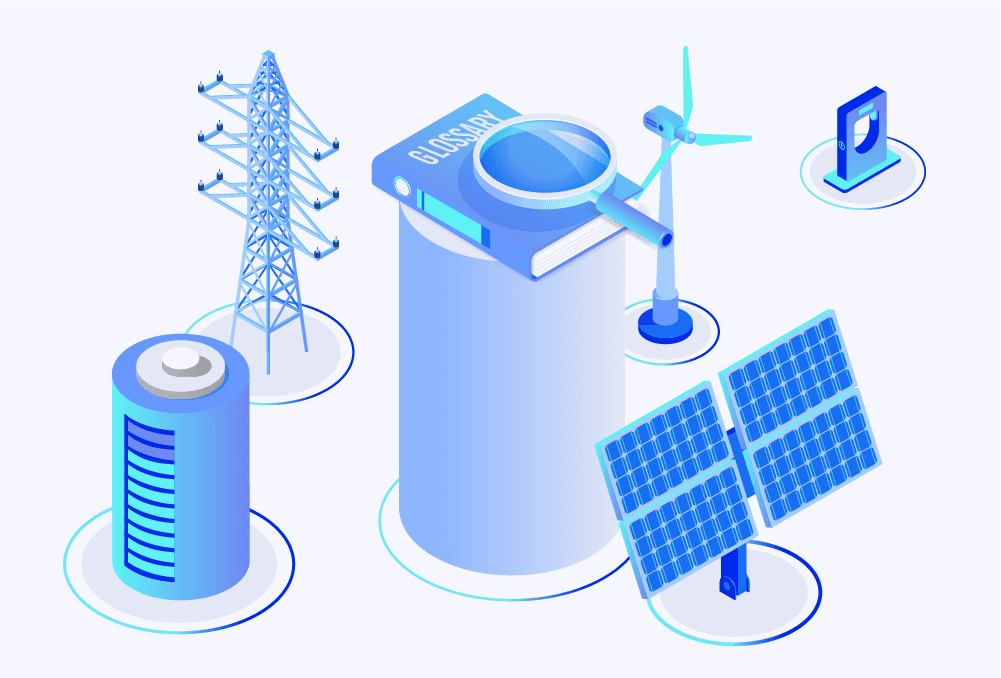As we’re now adding energy topics to our usual publications’ agenda, it might be a good moment to take a quick step back and break down some of the most recurring terms. Much like with the already well-known eMobility, the energy industry holds quite a word stock to itself. While some of them can be considered general knowledge, others not only cause some confusion, but are purely unknown to many people.
As the intricate industry befits, the nomenclature can seem impenetrable at first, but once the general grasp is held, there should be no more confusion.
The basics:
Alternating Current (AC)
This is a type of current that reverses its direction periodically. Generally, AC power is the most commonly used form of electricity based on the available voltage from the electrical grid. Being the fundamental form of electricity, AC current is what’s used to get devices like kitchen appliances, TVs, fans and lamps running in homes and businesses.
Direct current (DC)
DC is a type of current that flows in one single direction. As its name suggests, it does not change direction like AC. DC can flow freely through various mediums like wires, conductors and semiconductors. It is mainly used by various electrical devices such as computers and batteries, but also for some of the railways or electrochemical processes.
Distribution Network Operator (DNO)
DNOs are companies that own and operate networks for electricity transmission and distribution. They work as the link between generation sources, such as power plants or renewable energy sources, and consumers.
High voltage
It refers to a level of electrical potential that exceeds the usual safety threshold and necessitates extra precautionary measures when using related equipment or conductors. Put simply, high voltage is power strong enough to cause injuries or damages like fire hazard.
Electric current
This is the flow of electrons through a conductor. It expresses the rate at which electric energy is transferred, and it's measured in amperes (A).
Energy Conversion
Energy conversion is the process of converting one form of energy into another. For example, electricity is a type of energy that can be converted from other forms, such as coal or wind. This conversion process usually involves an energy source being transmitted through a generator and then transformed into usable electricity.
Base Load
This is the minimum amount of energy required to be generated by a power plant at any given time. Generally, it corresponds to the constant demand for electricity and is usually provided by large plants such as coal or nuclear power plants.
Renewable Energy
This refers to the energy obtained from sources that are not depleted when used. Examples of renewable energy include solar, wind, hydroelectric and geothermal power.
Load Management
This is a process that involves adjusting energy consumption to reduce peak electrical load. It includes techniques such as using more efficient appliances, scheduling the use of large appliances during off-peak hours, and curtailing nonessential uses of electricity during peak periods.
Micro-Generation
Micro-generation is a term used for small-scale electricity generation, typically in residential settings. It involves generating electricity using renewable energy sources such as solar photovoltaics, wind turbines or micro-hydro systems. This type of energy production can drastically reduce the demand on traditional power grids and help households become self-sufficient when it comes to their energy needs.
Peak Demand
Peak demand refers to the time of day when electricity usage is at its highest. This usually occurs during weekday afternoons and evenings due to increased residential, commercial and industrial loads. Managing peak demand can be a challenge for grid operators as they need to balance supply and demand in order to keep the system stable. To cope with these periods of high demand, electricity companies often encourage people to shift their energy habits to lower peak times and use energy more efficiently.
Measuring and units of measurement
AMP
An amp is a unit of electrical current that measures the amount of electricity flowing through an electric circuit. It’s abbreviated as ‘A’ and it can be used to measure the power supplied by a battery or generator
Watt
A watt is a unit of power that measures the rate at which electrical energy is used or generated. Watt is an equivalent to one joule per second.
Energy meter
An energy meter, also called a watt-hour meter or kilowatt-hour meter, is an instrument used to measure the amount of electrical energy consumed by a specific appliance or device. It measures the number of kilowatt-hours (kWh) that have been consumed and can be used to calculate electricity bills.
Electric power
It is the rate at which electrical energy is transferred by an electric circuit. Many people mistakenly believe that electric power is exchanged in the market - however, it's actually energy which exchanges hands. This makes sense when you consider electricity as a product of its two components: power and time. When we buy electricity from suppliers, this comes to us measured according to kilowatt-hours
Automatic Meter Read
Automatic meter read (AMR) is an advanced technology that automatically reads and transmits electric meter readings without any manual intervention. It eliminates the need for a technician to physically visit each customer’s premises in order to collect data.
Net Metering
Net metering is a billing system used by utilities that allows customers with micro-generation systems to be compensated for any excess electricity they generate. The system works by measuring the difference between the energy that a customer generates and the energy they consume. The amount of electricity generated is credited to the customer’s account, allowing them to offset their electricity costs and possibly even make a profit from their micro-generation system.
Hardware and devices
Circuit
A circuit is an electrical system that enables electricity to flow from one place to another. It consists of a number of components such as wires, resistors and capacitors. The purpose of using a circuit is to control the current by creating pathways for it to follow.
Circuit breaker
A circuit breaker is a device that is used to automatically shut off the flow of electricity when there is an overload or short circuit. It helps prevent damage to electrical systems by quickly disconnecting the current when an unusually high amount of electricity passes through it.
Power inverter
A power inverter is an electronic device that converts direct current (DC) electricity into alternating current (AC). This is done by changing the voltage and frequency of the DC signal so that it can be used in AC-powered devices such as lights, fans, and other equipment. Power inverters are often used to provide backup energy during power outages or to supply electricity in remote areas.
Electrical conductor
An electrical conductor is an object that allows electricity to flow through it. Conductors are usually made of metal and can be used to connect two points in a circuit so that the current can move from one point to the other. Common conductors include copper wires, aluminum foil, and certain types of plastics.
Fuse
A fuse is a device that contains a piece of metal, called a fuse wire, which is designed to melt when too much current passes through it. This helps to protect the circuit from being overloaded and prevents damage due to high voltages. Fuses are commonly found in electrical appliances.
Substation
Crucial points on the distribution map that transform voltage from high to low (or vice versa) and enable the transfer of energy between transmission systems and the distribution networks which then can bring it into homes.
Service drop
(the nomenclature may change depending on the region) overhead electrical line that delivers power from the pole to any building or residence. This is the final stretch before electricity ‘enters’ the building.
Distribution transformers
They bridge the gap between large energy networks and individual households. Acting as integral nodes in the electric power grid, these devices are vital for providing electricity to homes and businesses by taking high voltage input from distribution lines and transforming it into a lower output that is safe for everyday use.
Feeder
A backbone for electricity distribution, linking power from sub-stations to end user locations
Power Line
A power line is an electrical cable or wire used to transmit electric energy from one place to another. It typically consists of multiple cables bundled together and covered in an insulating material. Power lines are used for a variety of applications, including powering homes, business and industrial sites.
Other
Declared Net Capacity (DNC)
is a measure that reflects the output of an electricity generator, such as a power plant. It is expressed in kilowatts (kW) or megawatts (MW). DNC is determined by the amount of energy available from generation sources at any given time, taking into consideration constraints imposed by technology and economics. Factors such as fuel costs, maintenance schedules
Standing Charge
It’s the daily fixed fee paid to an energy supplier, usually by large-scale businesses, for maintaining their electricity supply. The standing charge is applied regardless of the amount of electricity used in any given period and can be an important factor when customers are deciding which electricity tariff is best for them.
Supply Number
It is a unique reference code given to each customer by their energy supplier. It is used by suppliers to identify customers and track usage and billing information. Supply numbers are typically five or six digits long, and can be found on all bills and statements sent out by the supplier.
Energy tariff
The rate of payment for a given supply of electricity and/or gas. Tariffs can vary between different suppliers, as well as different types of customers (e.g., domestic, business). The most common tariffs are fixed-term contracts, variable tariffs, and discounted tariffs.
Peaking Plant
These are power plants designed to produce electrical energy mainly during peak periods when there’s an increased demand for electricity. They are used to supplement the base load that is provided by large power plants.

